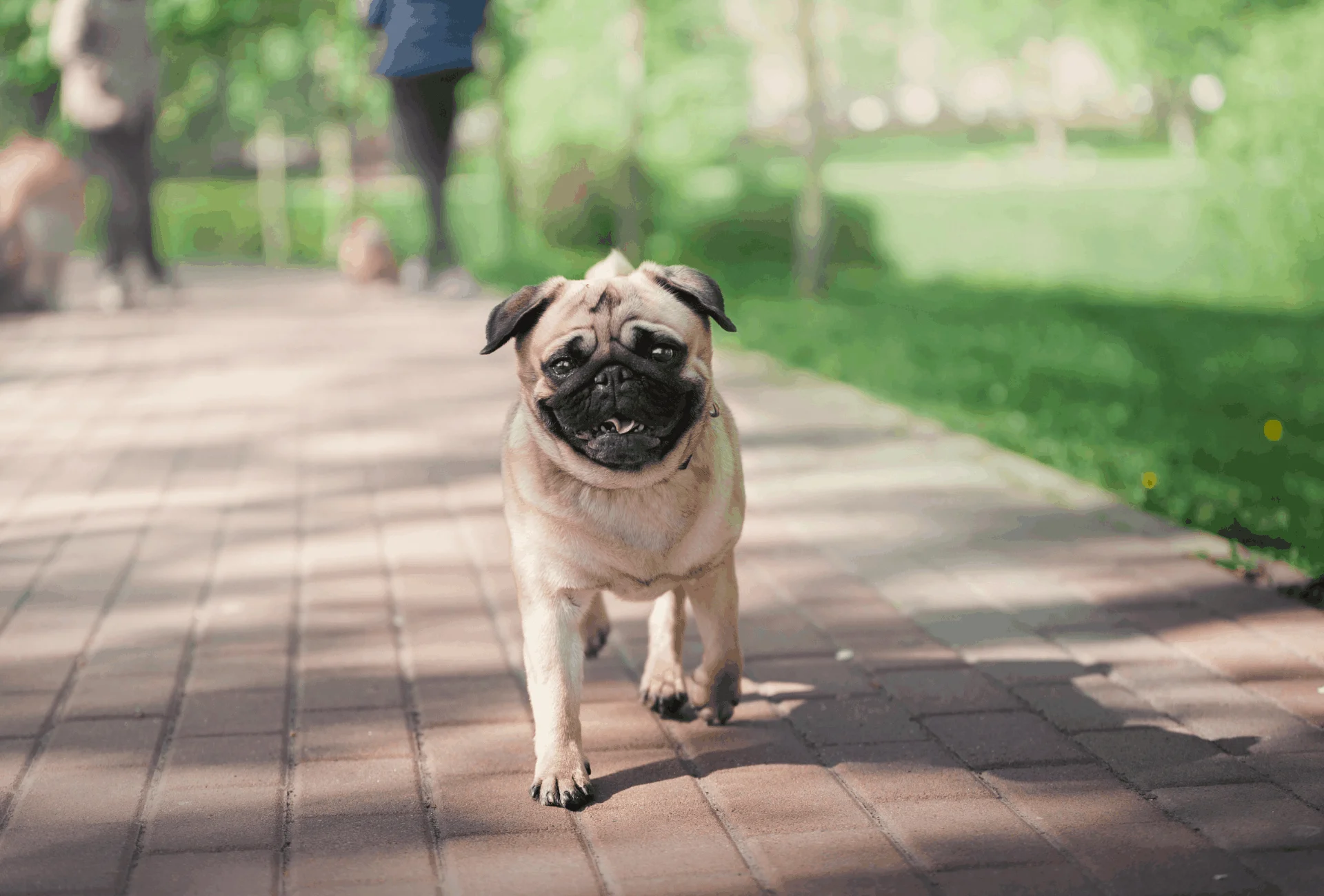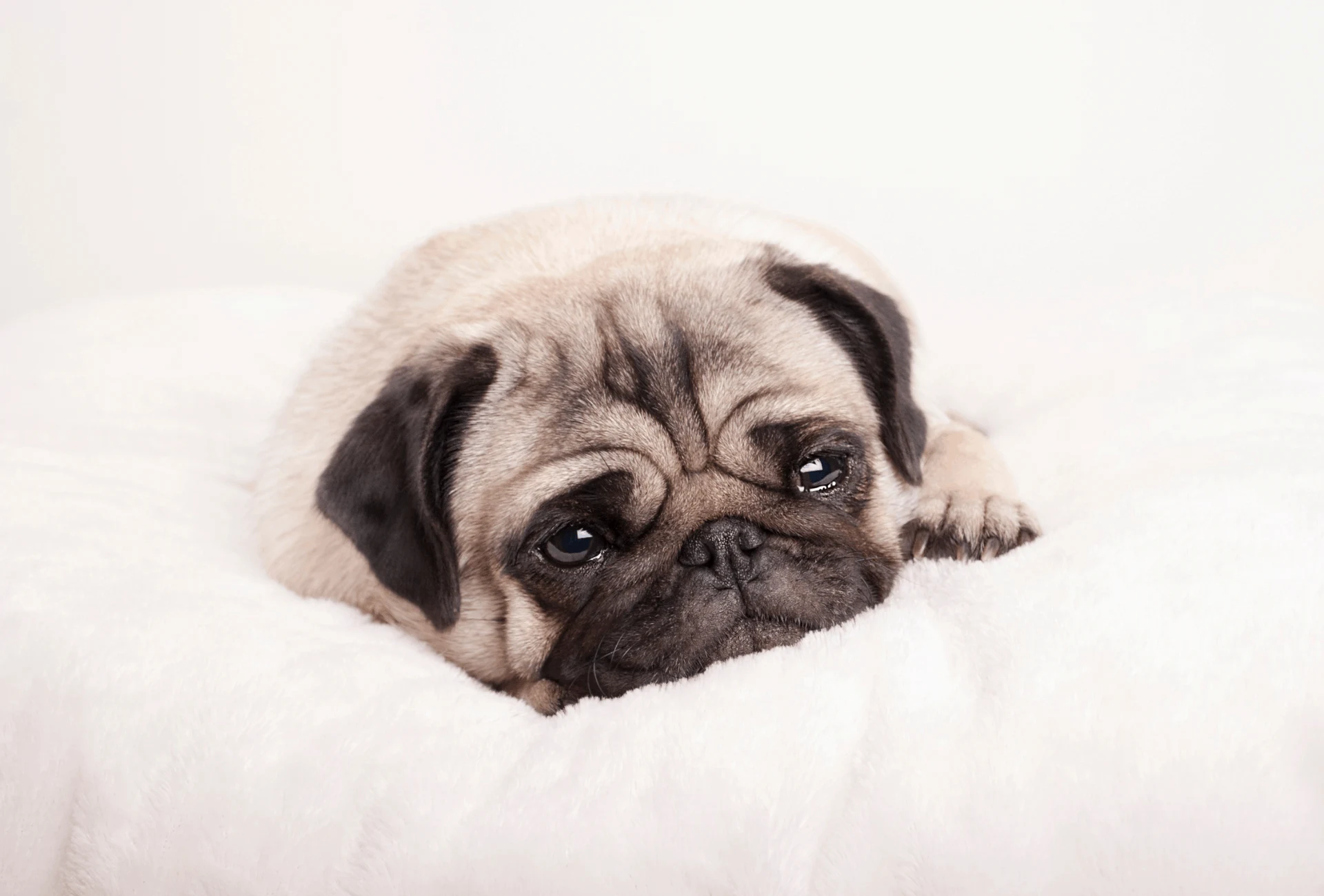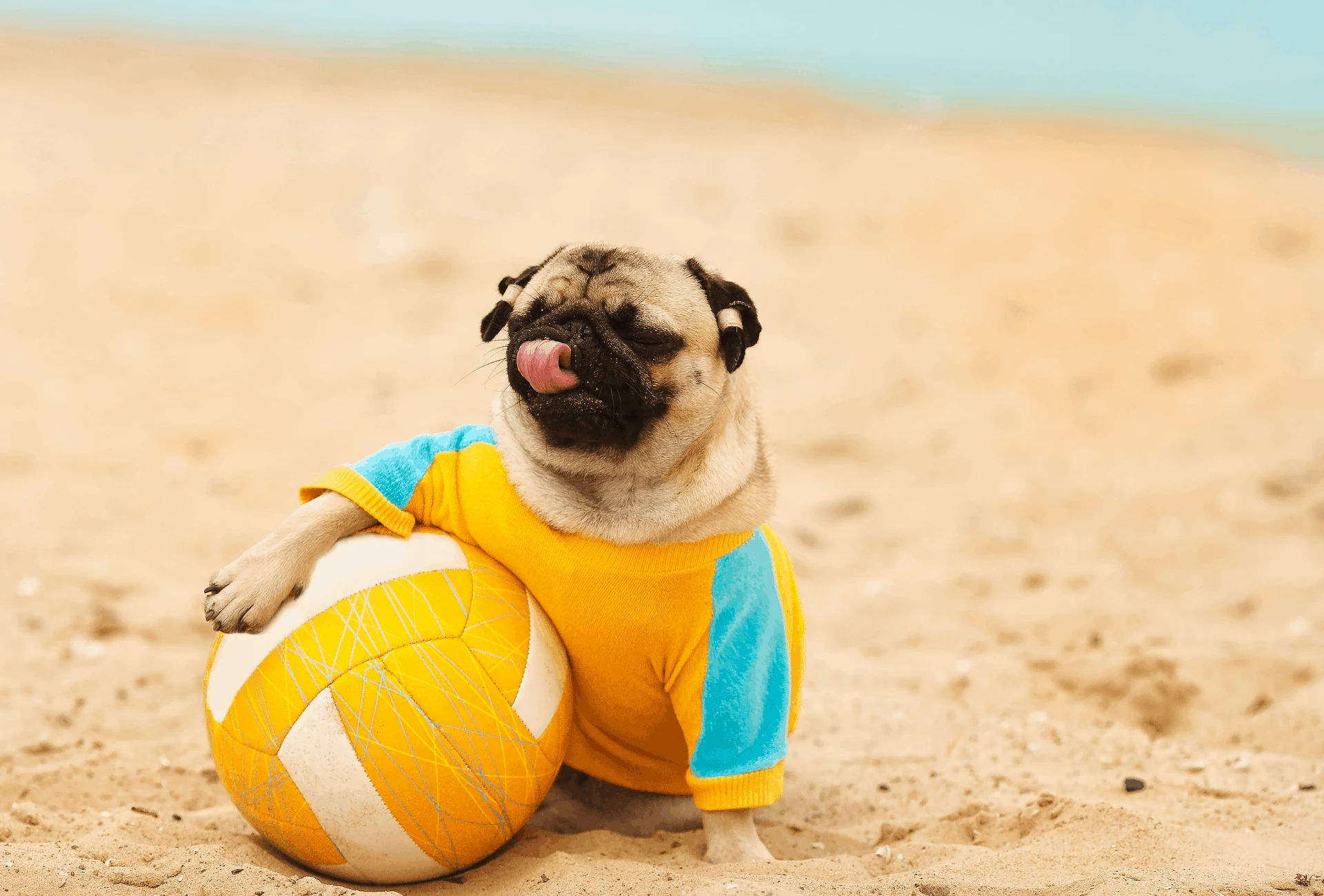With ancient roots dating far back to around 400 BC, Pugs are a very old dog breed with a unique history.
Most fanciers agree these dogs originated in Asia, bred for Chinese nobility.
These compact dogs soon exploded in popularity, often prized equal to the Chinese emperor’s wives, and provided their own guards.
Tibetan Buddhist monks also favored their company in quiet monasteries.
As loving companions we want them to stay with us as long as possible.
But how long do Pugs usually live and what can you do to increase their lifespan? Let’s find out!
Pug Average Lifespan
According to the AKC, Pugs average a nicely-lived lifespan of 13-15 years. Most other credible sources will set them around this age range.
In general, the majority of smaller dog breeds tend to enjoy longer life spans than that of larger breeds.
For example, a Great Dane might live around 8-10 years or 6-12 for the many dogs falling under the Mastiff category.
With a healthy level of care, good exercise and nutrition, and an adequate upbringing in general, you can increase the chances of your Pug living a long, happy life.

What Is the Oldest Living Pug?
A pug named Snookie passed in South Africa on October 12, 2018, at an unbelievable 27 years old (supposedly), easily making him the oldest recorded dog of his breed to have ever lived.
Records aren’t always kept so it might be impossible to prove his story, but ‘King Tug the Pug’ is supposedly the oldest living Pug as of 2020, at a whopping 18 years old.
Previously people thought that an average of 7 dog years equals 1 human year, this would put him at 126 which is a bit unrealistic.
A very recent study has found that you are able to calculate how old your dog would be in human years by multiplying the natural logarithm of the dog’s age by 16 and then adding 31.
For some easy references, a one-year-old dog would be 31 years old and a four-year-old dog 53. King Tug the Pug would be about 95 years old.
Of course, this is based on a universal formula and doesn’t account for physiological differences in dog breeds.
Make sure to follow our helpful Pug care list below in order to ensure your pet stays with you as long as possible.
Leading Causes of Death in Pugs
Neurological disorders are believed to be the number one natural cause, or causes, of death in Pugs.
This would actually include any disorder affecting a pug’s nervous system, which could be more appropriately called the top class of death related causes.
Pug Dog Encephalitis
More specifically called Necrotizing meningoencephalitis (NME), this disease causes inflammation of the brain, and is normally fatal for the dog.
Scientists have linked this to certain genetic markers more often found in female Pugs.
Symptoms often include depression, seizures, blindness, ataxia (loss of muscle control), and an unusual gait. An estimated 1.2% of all Pugs will die from this, which is actually a significant number considering the breed’s popularity.
Pug Common Health Issues
Like nearly all dog breeds, Pugs have their fair share of common health concerns. Becoming aware of these possibilities is always recommended for any dog parent.
Legg-Perthes Disease
This disorder commonly affects toy or smaller breeds, causing a constant limp that is usually very painful. If untreated (and often regardless), it can lead to loss of cartilage, arthritis, loss of muscle mass, and others.
When the head of the femur lacks an adequate blood supply, it will start to become necrotic and die.
Bone loss in any area can be a huge problem, but especially when you are dealing with a joint meant to support your dog’s weight.
Skin Disorders/Complications
Because Pugs have more skin folds than most breeds, and their mask area is usually moist, they are more susceptible to skin issues. These moist, warm areas can collect and promote bacteria, providing good conditions for infection.
To keep your Pug’s wrinkles clean and dry at all times I highly recommend the unscented Pogi’s Grooming Wipes which are hypoallergenic and environmentally friendly.
Lip-Fold Pyoderma
This form of dermatitis (inflammation of the skin) is another term for pyoderma, the medical term used for a bacterial skin infection.
Like the description above, close contact skin folds, especially surrounding the face and excess moisture, increases chances for this to develop.
The condition can usually be treated very easily by ensuring the area stays as clean and dry as possible. This is also a good method for prevention.

Respiratory Issues
A shorter, narrow upper respiratory tract can lead to things like collapsing snares, increased snoring, collapsing tracheal rings, and difficulty panting.
Since dogs use panting as a primary heat exchange method, this can lead to increased heat injuries.
Brachycephalic Airway Obstruction Syndrome
In brachycephalic dogs (Pugs fall in this category), the animal’s skull bones are shortened, changing the normal canine anatomy. Many structures are either closer or smaller than they otherwise naturally would be.
This term includes a group of upper airway problems that afflict brachycephalic dogs. Pugs fall into this category and are prone to be affected by either one or a combination of the conditions below:
- Stenotic nares
- Extended nasopharyngeal turbinates
- Elongated soft palate
- Laryngeal collapse
- Hypoplastic trachea
- Everted laryngeal saccules
Canine Hip Dysplasia
Canine hip dysplasia is a self-explanatory term, describing a ‘displaced’ hip. The ‘ball and socket’ joint of the hip doesn’t fit together properly, leading to symptoms like discomfort, arthritis, or other joint conditions.
Hip dysplasia has been linked to genetics and is often found in larger breeds (in addition to Pugs). Poor nutrition, excess weight, and rapid growth can also contribute.
How to Increase Your Pug’s Lifespan
No Pug parent or dog lover wants their beloved fur-children to suffer. We want to give them the longest, happiest lives possible, and most of us would be willing to travel to great lengths for that end.
Willingness to go the extra mile for these adorable little creatures simply isn’t enough. How do we increase our Pug’s lifespan?
The Right Breeder
Adoption is always recommended by any rescue operator, but you absolutely want to vet your breeder if you don’t choose that route.
Always ask for health-related and vaccination paperwork, and request about the health history of the dam and sire. Make sure your chosen puppy is both de-wormed and has received a comprehensive set of vaccinations.
Never purchase your puppy over the internet without first meeting both he/she and the breeder. Purchasing a dog over the internet or by mail is never recommended.
Look into the credibility and history of your chosen breeder. Who has certified them, and what do past clients have to say about them?
Our convenient guide, All 17 Questions You Need to Ask Your Potential Breeder, will offer valuable insight for your search.
If you would rather adopt a Pug in need of a forever home, take a look at our dog adoption guide for future pet owners.
Veterinary Care
Always ensure you are offering current medical care with regular checkups. Make sure your pet is always current on vaccinations, and never ignore any possible medical problem.
Even the most devout owners might miss subtle physical cues indicating problems, or changes in behavior. If you notice any signs of illness, do not wait and take your dog to the vet sooner rather than later.
Nutrition
Pet obesity is a huge problem in America today. Human obesity rates are bad, but our dog/cat obesity rates are much higher and they don’t know any better.
Do some research into the ideal nutritional requirements for your pug. Never just purchase dog food based on expense; there is almost always a very good reason why it may be so cheap. Don’t be fooled by attractive advertising or popularity.
Avoid most human (i.e. fatty, carb-rich, or salty) foods. Dog food is normally designed to offer a correct mixture of nutrients, without too much excess (usually).
Try to place a higher emphasis on animal/meat proteins and fatty content secondary, with a lower percentage of starchy or carbohydrate-heavy ingredients.
This will automatically eliminate the majority of manufactured pet foods, making your decision easier.
“Any diet should be appropriate to the dog’s age (puppy, adult, or senior). Pugs love to eat and are prone to obesity, so watch your dog’s calorie consumption and weight level.”
AKC
Exercise
In addition to high quality nutrition, make sure you provide opportunities for quality exercise. Your pug may not be able to keep up on walks, but even play can help burn off excess calories.
“It’s vital to remember that as a short-faced breed Pugs aren’t tolerant of hot weather, and they shouldn’t do strenuous exercise when it’s warm or humid out—better to be in air-conditioning.“
AKC
Don’t forget to also provide enough mental stimulation in form of brain games or training which will help keep your dog fit and satisfied.
Summer Caution
Because Pugs tend to have difficulty panting properly, they can be much more prone to developing heat-related injuries. Most dogs don’t sweat like humans do (other than select areas, like paw pads), and rely on panting as a method of perspiration.
We, and other animals, sweat as a way of limiting or lowering our body temperatures. If a pug can’t regulate his body temperature on a hot day, heat injuries become much more likely.

Water Caution
At the same time, always provide constant supervision around bodies of water deeper than your pet’s waist level. Some breeds simply weren’t meant to swim, and many Pugs have met their ends this way.
If you are providing a wading pool during the summer, be sure it is either shallow or you are with your pet (preferably both). Remember, you don’t want your Pug outdoors long in the heat.
Remember your wet Pug is prone to develop bacterial infections around those many wrinkles, so try to ensure he is kept clean and dry.
Genetic Testing
Thanks to both the ever-growing pet care industry and modern advances in veterinary science, genetic testing is easily available to those that can afford it. Since Pugs are known for certain hereditary health complications, these can be especially helpful.
A pet parent would know what risks to avoid and what medical concerns to watch out for. Genetic testing can help with:
- Identify potential hereditary or genetic concerns
- Identify family lineage and breeding history
- Beneficial to breeders
- Enhance the value of pups
Socialize Your Pug
Unfortunately, many small breed pet owners never bother to socialize their dogs at a young age. They believe that small dogs couldn’t harm anyone anyways.
Sadly, this frequently leads to overly anxious dogs who are always on guard, stressed, or aggressive to other humans and animals alike. Depression rates and other health problems can be higher in poorly socialized dogs.
Not only is dog socialization extremely simple for those dog parents eager to learn, but it might also just be the absolute best form of behavior related training your dog will ever get.
Spending Time Bonding with Your Pug
Dogs are very social animals and rely heavily on family members for support (whether they be dogs or humans). No dog will be truly happy unless he is able to spend plenty of quality time with his owner.
Bonding should never just stop with a single human handler. Socialize your Pug at an early age, so he is able to enjoy life around other animals and people.
Train your pug to eliminate the potential for separation anxiety. Some dogs have become so anxious they’ve caused themselves physical harm, and anxiety isn’t good for mental health in general.
Health Insurance
Many dog owners have never even heard of pet insurance, but it is almost as prevalent today as human health insurance.
There are several options for any pet owner, but the best type would probably be a plan that covers enormous unexpected expenses.
For example, your pet might need $4,000 emergency surgery you simply can’t afford.
If you have been investing small amounts monthly in this type of emergency coverage, you might only pay a few hundred dollars for something that otherwise would have certainly ended much worse.

Tet
Monday 16th of August 2021
Our pug, Casey, is turning 21 in Jan 2022. He can't see well due to mild cataracts, on heart medication for maintenance, got stiff legs and sometimes can't walk on bad days... but still pretty healthy considering his age and his vet was quite amazed on the result of his last blood test and check up. He is our dear little boy and love him to bits.
Danielle
Friday 27th of August 2021
Hi Tet, wow that's really old for any dog breed! Sad that he has these issues but yeah, considering his age it's still great if he has a good overall quality of life. Hope Casey stays healthy!
Cheers, Danielle
Christina Hasty
Thursday 6th of May 2021
My Pug, Lucy, is 21 years old. She will be 22 in October. She is blind and deaf but she still gets around easily. She needs to be with me and sleeps with me with her head on my pillow. It will heart breaking when she goes but she and I have had a long, loving life together.
Danielle
Thursday 6th of May 2021
Hi Christina, wow 21 years is incredible. Sad that she's blind and deaf but I hope she's still enjoying her life to the fullest potential, especially if she still gets around easily!
Cheers to Lucy, Danielle